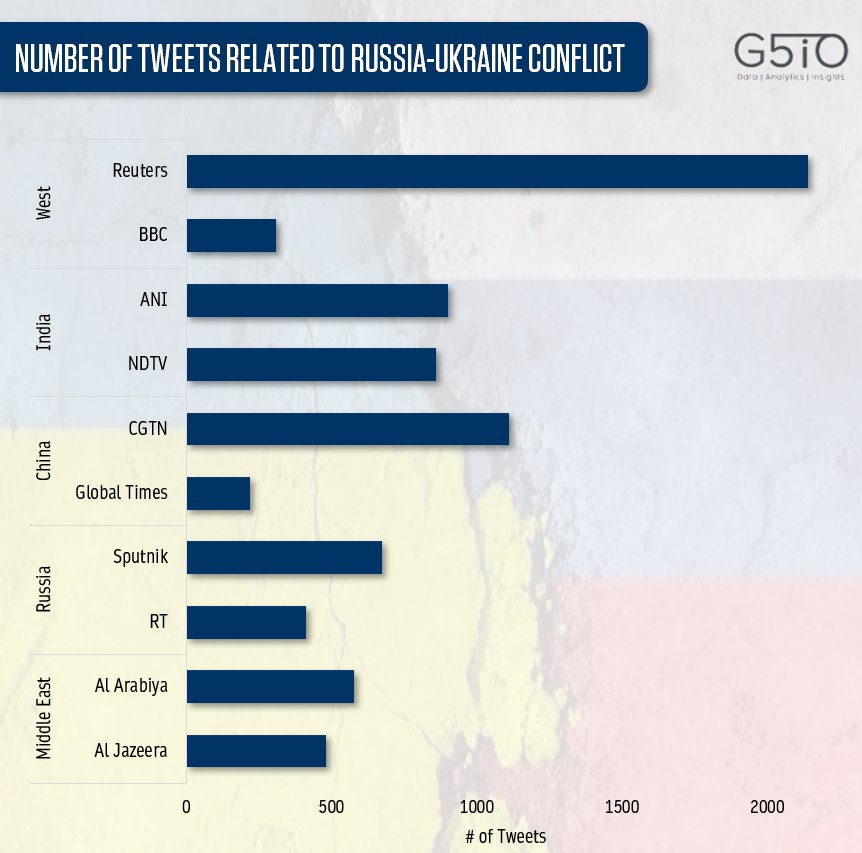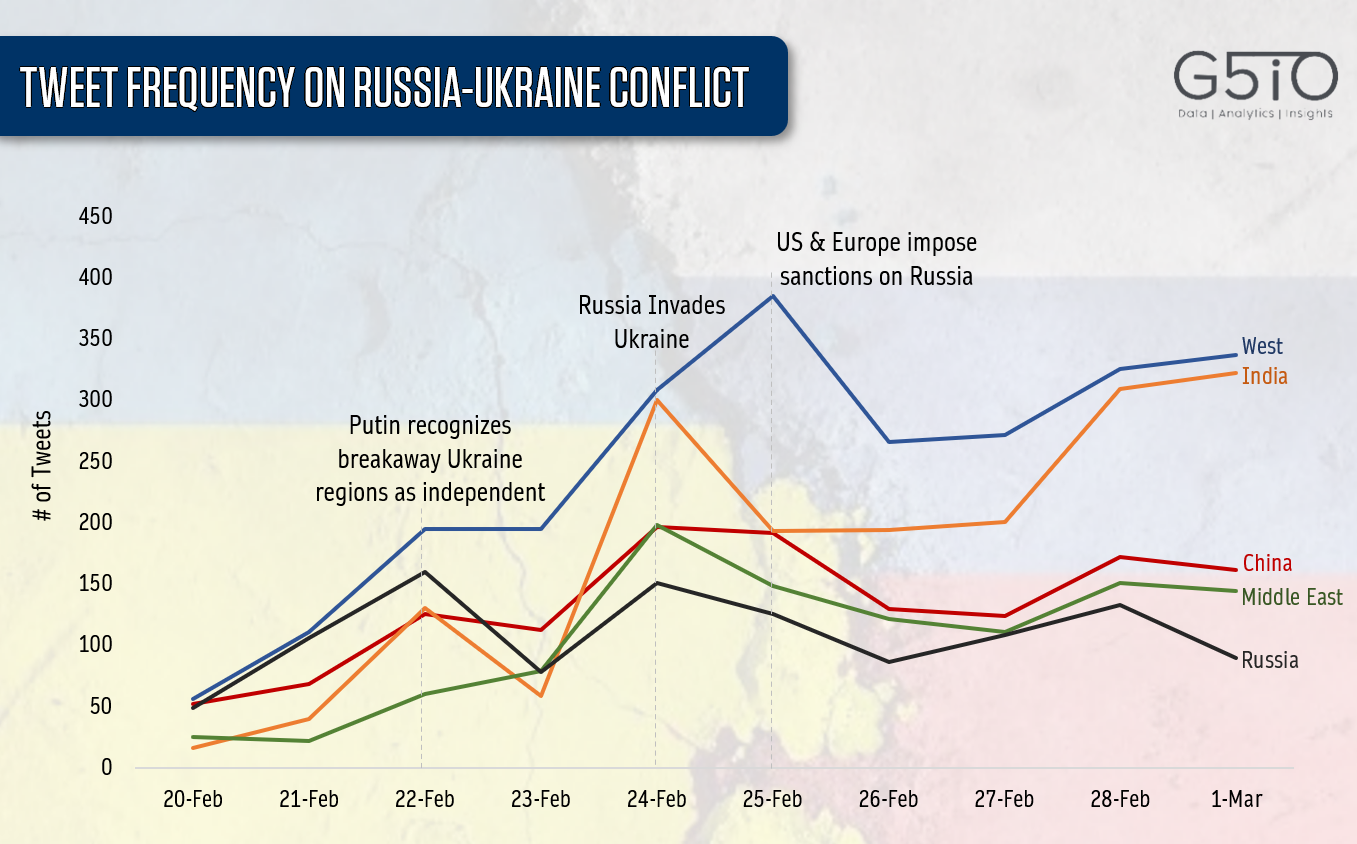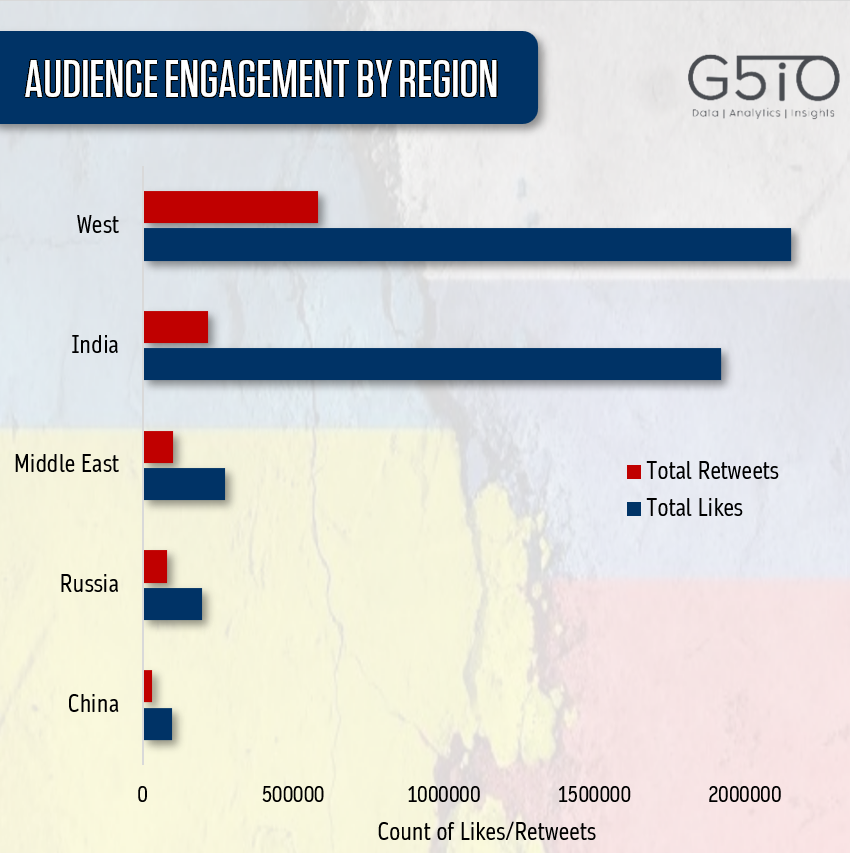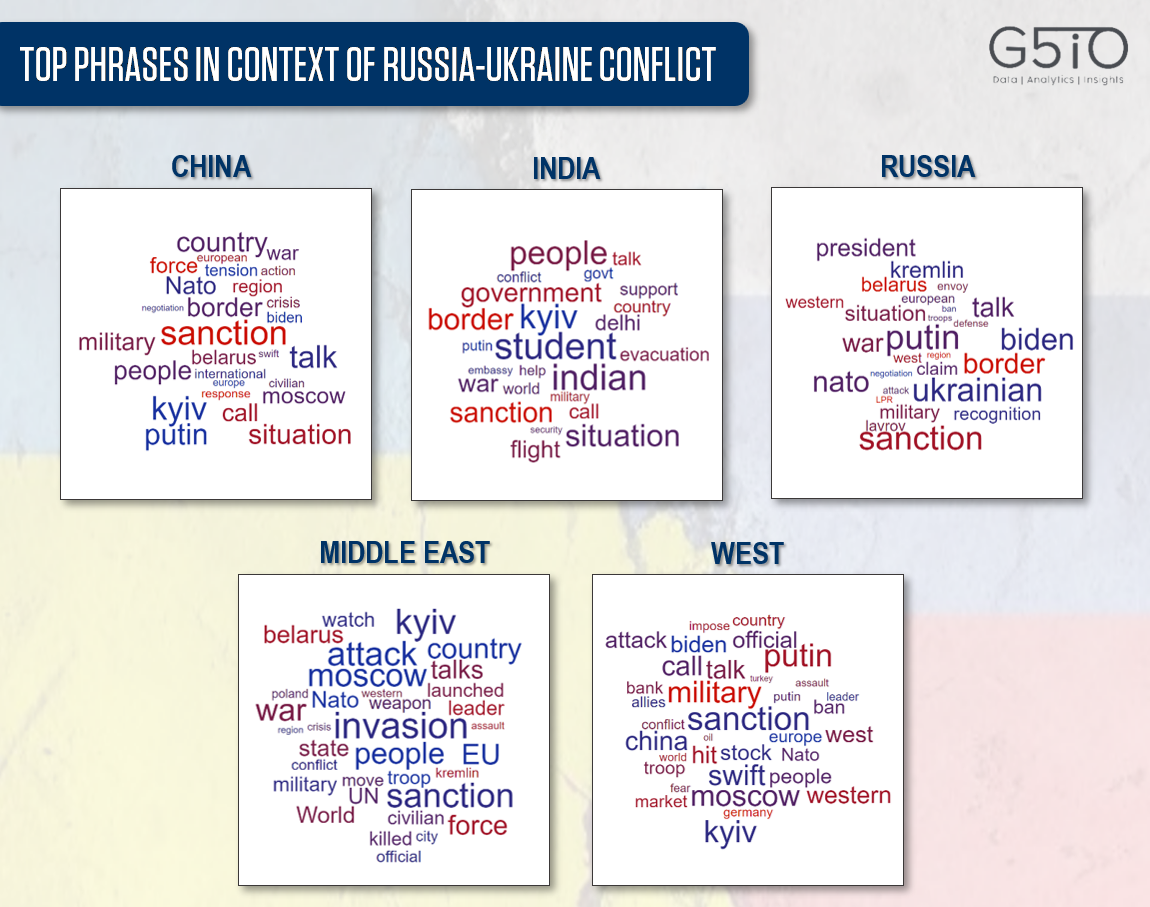Overview:
Given the ongoing Russia Ukraine conflict and its fast-evolving media discourses, we investigated Twitter timelines of major world media houses to compare their reporting on the conflict. Our primary goal was to see whether there were any variations between major international media outlets and their reporting depending on where they were based.
Methodology:
Our analysis is derived from a detailed study of (A) Tweet patterns and (B) a thorough content analysis of 10 Twitter accounts of major news outlets. These were scraped from two English language media outlets each from the ‘West’, Russia, China, India, and the Middle East comprising a total of 32800 tweets. These were sourced using Twitter’s rest API, out of which only those tweets were filtered that directly referred to the Russian Ukraine conflict. The final data set comprised roughly 7800 tweets that were posted between 20th Feb and 1st March.
A. Tweet Activity Patterns
Frequency of Tweets:
Seeing how our dataset was sourced from twitter, it was already expected that total tweet volumes would be skewed more towards our sampled Western media outlets. These for instance included over 2000 tweets by Reuters which were more than double than those of the next most active networks such as the Chinese CGTN and Indian ANI outlets. Interestingly, Russia based English language networks ranked 4th in our list, just slightly above Middle Eastern based networks.

While Tweet Frequency numbers present a more general picture of the overall ‘coverage’ given to the crisis, it is perhaps more interesting to see how these numbers fluctuated in comparison with one another as the crisis unfolded and escalated throughout the period analyzed. For instance, up until the recognition of the Donetsk and Luhansk People’s Republics, both Russian and Western outlets were almost neck and neck in terms of their coverage. These trends changed dramatically once Russian forces began their attack on 24th Feb, with Russian media visibly downplaying the event while Western and Indian media exhibited a dramatic increase in their tweet activity.
The following days however saw coverage of the conflict in Western media diverge considerably with the rest as the US and Europe jointly imposed sanctions on Russia.

User Engagement:
Comparing the above coverage with the amount of social media engagement received by each network, we saw some interesting patterns with regards to the kind of traction gained across twitter. As mentioned above, Western and Indian outlets received the most engagement owing to the sheer size of their audience on twitter. In contrast both Russian and Chinese networks saw the least amount of engagement in essence testifying to Twitter’s own limited reach and popularity as a platform within these regions.

B. Tweet Content Analysis
Top Hashtags:
Taking a closer look at the content of the tweets analyzed we wanted to see what kind of wording and phrasing was used by each outlet in their coverage and whether there were any distinct patterns that stood out. This was done firstly by taking a quick look at the most frequently used hashtags by each media outlet to gauge which actors and sub-issues were emphasized the most in their coverage of the conflict. For instance, the top Hashtags used by Russian media outlets focused on #Sanctions and a greater emphasis on the breakaway regions of #Donbass and #Donetsk. In contrast, Chinese media outlets emphasized instead the direct roles played by the #US and #Putin and their impact on #Kyiv and #China. Similarly, Middle Eastern outlets allotted similar importance to not just #Putin and the #US but also to the #EU and #NATO. In contrast, Indian media focused primarily on highlighting the Indian govt’s own efforts in evacuating Indian students from Ukraine as part of #Operationganga. No hashtags were used by the Reuters or BBC throughout their coverage of the conflict via their official twitter accounts.

Textual Analysis:
A look at the most frequently used words within our dataset however allows for a deeper understanding into the varying ways in which coverage of the crisis has been framed by each outlet. For instance, the emphasis on sanctions remained a constant theme throughout our data set whilst remaining central to both Western and Chinese media outlets’ coverage of the crisis. However, while Western outlets emphasized more on the Russian ‘attack’ calling for ‘swift’ measures, Chinese outlets focused instead more on ‘talks’ over respecting ‘border(s)’. Similarly, while Russian outlets also focused on ‘sanctions’ there was a greater emphasis on ‘President’ ‘Putin’ testifying to his central role, especially in relation to US President ‘Biden’ and ‘NATO’. This again stands in stark contrast to Middle Eastern outlets which aimed to highlight instead the impact and effect of the ‘invasion’ as an ‘attack’ on the ‘people’ without referring directly to leaders and causes.
In contrast to all of the above, Indian media on the other hand while *providing extensive coverage on the crisis did so mostly within the context of the Indian government’s own efforts at evacuating and rescuing stranded ‘Indian’ ‘students. Their overall context and audience limited mostly to amplifying the BJP govt’s prowess and prestige during ongoing state elections.

Conclusion:
On the whole, the following insights were gleaned from our study:
- Frequency of reporting on the Ukrainian conflict saw variance in different regions based on the events unfolding. Russian media downplayed the situation once the war ensued. This was in contrast to Western Media which double downed on their reporting of the conflict especially following the imposition of sanctions
- Western and Indian media outlets received highest user engagement on Twitter compared to Russian and Chinese outlets. Thus, depicting how Western based social media platforms such as Twitter have become an echo chamber for Western narratives.
- Media outlets have either augmented or self-censored their reporting in accordance with the official state narratives of where they are based.
Download PDF:

Diverging Narratives – How Global Media Responded to the Ukraine Conflict
